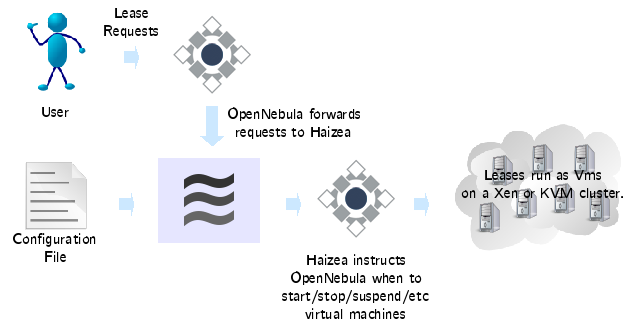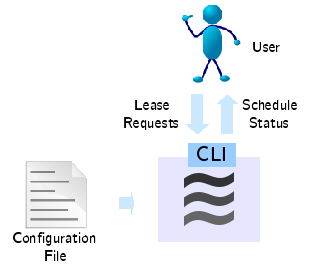Next: 2 Haizea architecture Up: 2 What is Haizea? Previous: 2 What is Haizea? Contents
Haizea is, primarily, a VM resource management component that takes lease requests and makes scheduling decisions based on those requests, but doesn't actually know anything about how to enact those decisions. For example, Haizea may determine at what times a set of VMs representing a lease must start and stop, but it doesn't actually know how to instruct a virtual machine manager (such as Xen, KVM, etc.) to do these actions. Haizea can, however, delegate these enactment actions to an external component using a simple API. Haizea can currently interface with the OpenNebula (http://www.opennebula.org/) virtual infrastructure manager to enact its scheduling decisions. Haizea can also simulate enactment actions, which makes it useful for doing scheduling research involving leases or VMs (in fact, the Haizea simulator has been used in a couple of papers).
So, Haizea can be used in three modes: OpenNebula mode, unattended simulation mode, and interactive simulation mode.

Haizea can be used as a drop-in replacement for OpenNebula's scheduling daemon. OpenNebula is a virtual infrastructure manager that enables the dynamic deployment and re-allocation of virtual machines on a pool of physical resources. OpenNebula and Haizea complement each other, since OpenNebula provides all the enactment muscle (OpenNebula can manage Xen and KVM virtual machines on a cluster, with VMWare support to follow shortly) while Haizea provides all the scheduling brains.
Chapter 6 describes how to use Haizea and OpenNebula together.

In this mode, Haizea takes a list of lease requests (specified in a tracefile) and a configuration file specifying simulation and scheduling options (such as the characteristics of the hardware to simulate), and processes them in ``simulated time''. In other words, the goal of this mode is to obtain the final schedule for a set of leases, without having to wait for all those leases to complete in real time (this makes this mode particularly useful to find out what effect a certain scheduling option could have over a period of weeks or months). In fact, the final result of an unattended simulation is a datafile with raw scheduling data and metrics which can be used to generate reports and graphs.
Chapter 4 provides a quickstart-style introduction to running Haizea in unattended simulation mode, and Chapter 5 explains simulation options in more detail. Analysis of the scheduling data generated by an unattended simulation is covered in Chapter 7

In this mode, enactment actions are simulated, but Haizea runs in ``real time''. This means that, instead of having to provide a list of lease requests beforehand, your can use Haizea's command-line interface to request leases interactively and query the status of Haizea's schedule (e.g., to find out the state of lease you've requested). Obviously, this mode is not useful if you want to simulate weeks or months of requests, but it is handy if you want to experiment with leases and track the schedule in a more user-friendly way (since the datafile produced by the unattended simulation is mostly meant for consumption by other programs, e.g., to generate graphs and reports).
Chapter 4, the quickstart-style introduction, also includes instructions on how to run Haizea in interactive simulation mode.
Borja Sotomayor 2009-12-17